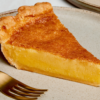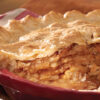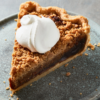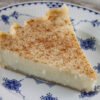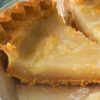Desperation Pies
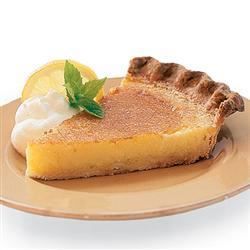
Pies that got America through the hard times.
In August of 1929, a series of major miscalculations by the Federal Reserve contributed to the worst financial disaster in American history. Known as The Great Depression, this cataclysm lasted for over a decade, starting with the stock market crash of ’29, causing regional banking panics throughout the country and ending with the total collapse of the U.S. commercial banking system. This national crisis was of such proportions that almost overnight more than 15 million people became unemployed, thousands homeless, and even more wondering where their next meal would come from.
The Great Depression brought with it a number of major changes in the American food scene as well. For most families, those lean years brought a number of major challenges—how to acquire food, how to make it last, and how to turn the limited ingredients that were available into tasty, nutritious meals.
Another challenge faced by homemakers during those very difficult years was how, in spite of the many ingredient shortages, to provide their families with something sweet to help relieve tensions brought about by the days hardships.
Since pie is so synonymous with the American culture, we’ve featured ten pies from the era. Sometimes called “desperation” or “make-do” pies, we should note that while not all were developed as a result of the Great Depression, they were all created during modest times in America’s history and thus returned as household favorites. Even today several of these pies are making a comeback.
Water Pie
That’s right folks, water pie. Born out of the Great Depression, the main ingredient in this pie is water. Flour, salt, sugar, butter, vanilla, and a touch of cider vinegar make up the remaining ingredients in this simple, easy-to-make dessert.
I know some of you are cringing at the thought of what pie with such a strange name might taste like. But it's actually pretty darn good. Think pecan pie minus the pecans, and you have some idea of how it will play on your palate. And that thin layer of butter that forms on the pie’s surface after chilling overnight to set, will melt on your tongue and fill your mouth with buttery richness.
Buttermilk Pie
During the Depression era, buttermilk was for many families a means of survival. For those who churned their own butter, it was a natural by-product. For those unable to churn at home, buttermilk was available from the local creamery where, more times than not, it was given out free.
Buttermilk is not only nutritious but filling as well. I’ve heard many of my parents' friends tell me about times when a glass or two of buttermilk was all they had for dinner, reserving whatever food was available for their children.
In this pie, buttermilk is the star. Add a couple of eggs, some vanilla, sugar, and flour, pour it into a pie shell, bake until set, and you have a delicious sweet and tangy pie that everyone will enjoy. Cost? Pennies.
Shoofly Pie
This poverty pie actually started as a crustless molasses coffee cake first baked in 1876 for the U.S. Centennial in Philadelphia. Sometime between then and the early 1880s a crust was added to make the pie easier to eat without the need for a plate or fork.
Traditionally shoofly pie was not served as dessert, but rather a breakfast food served alongside a cup of hot coffee. Described as crumb cake baked in a pie shell, its primary ingredients consist of molasses, brown sugar, and water. And since it originally contained no eggs, leavened instead with baking powder, historians conclude it was a winter treat, as hens lay much fewer eggs in the cold weather. Eggs were added in the 1920s.
Probably the most cited folk lore concerning shoofly pie’s unusual name is the one about how the little pools of sweet molasses that formed on the pies cooling on the kitchen windowsill attracted so many flies that the baker’s children were tasked with shooing them away until cool enough to put into the pie cabinet.
Actually, the pie got its name from Shoofly the Boxing Mule who was part of a circus traveling throughout southeastern Pennsylvania. The mule, whose name was taken from the popular song, “Shoo-fly, Don’t Bother Me,” had been trained to stand on his hind legs wearing boxing gloves on his front hooves. He became so popular and well- liked that people began naming products such as Shoofly Flour and Shoofly Molasses in his honor, and of course Shoofly Pie.
Mock Apple Pie
Sometimes referred to as “Cracker Pie,” mock apple pie is thought to date back to the early to mid-1800s, although the actual date is unknown. The earliest recipe found comes from the February 14, 1857 issue of Saturday Evening Post, that describes not only the basic “how to,” but clearly why this pie was created:
“As apples are very scarce in many sections of the country, I think the housewife will find the following recipe for making an apple pie out of crackers, very acceptable. For a common sized baking plate, take four of the square or six of the round crackers, a teacupfull of sugar, and a teaspoonfull of tartaric acid; break the crackers into a pint of water, add the sugar and acid and finish as an apple pie.”
Probably the most well known recipe for mock apple pie comes from Nabisco, who adapted their version from those using soda crackers (also called saltines). While certainly not the pie’s inventor, Nabisco was extremely instrumental in boosting it to national popularity by printing the recipe on the back of their Ritz cracker boxes from about 1935 until the late 1980s. After receiving more than 1,500 letters in just the first year after removing it, Nabisco resurrected the practice in 1991. Even today, it’s the most requested Nabisco recipe.
While it may only be mind over matter, most folks will agree that mock apple pie looks, smells, and tastes like apple pie. In fact there have been several scientific studies made to determine if in fact it does or does not. Truth is, you should bake this simple pie and judge the results for yourself.
Vinegar Pie
While considered a popular depression-era pie, this dessert was actually born in the mid-1800s during another time when frugality and scarceness of ingredients were the watchword. The first vinegar pies were actually more spartan than those of the early twentieth century, usually consisting only of water, molasses, vinegar, and flour, cooked on the stove and poured into a pie shell and fitted with a lattice top crust.
By the time of the Great Depression, recipes for vinegar pie had been altered to include sugar, butter, and eggs. Some called for separating the eggs and using the whites to make a meringue for topping the pie.
With a taste that mimics lemon pie, this “make-do” pie could be made from staples found in practically every home cooks kitchen.
Egg Pie
This humble dessert, like other so-called desperation pies, was created to utilize ingredients that a housewife usually had on hand or that were easy to come by. A close cousin of chess and buttermilk pies, egg pie (also known as egg custard pie) is a custard-based confection made with eggs, sugar, and milk or cream baked in a flaky crust. The addition of nutmeg gives this pie a luscious, silky, sweet filling, as well as a warm homey fragrance.
Sugar Cream Pie
Thought to have originated in the 1800s in Indiana’s Amish and Shaker communities. Named the official state pie of Indiana in 2009, sugar cream pie (also called Hoosier sugar cream pie, Quebec sugar cream pie, and Tartes au sucre) is a simple pie made by the combination of flour, butter, salt, vanilla, heavy cream, and sugar. Experienced pie cooks will notice the absence of eggs in this pie. One other unusual thing about this pie is how its filling is mixed directly in the pie shell with the cooks finger rather than in bowl.
Chocolate Fudge Pie
This simple but delicious pie dates back to Tennessee sometime between the late 1800s and early 1900s, and remains a popular dessert even today in a number of the state’s eateries. Made using ingredients available to most households — flour, butter, sugar, cocoa or baking chocolate, eggs, and vanilla — this southern treat was a staple at family reunions and church suppers, even at a time of scarcity, a testament to America’s love of chocolate and pies.
Chess Pie
While most people believe chess pie, like buttermilk pie, is a Southern dessert, it actually came to America from England as a deviation of the English cheese pie. In fact the name “chess” is thought to be a corruption of the word “cheese.” The first recipe for chess pie as we know it appeared in the 1877 cookbook Buckeye Cookery by Estelle Woods Wilcox.
Today there are any number of chess pie recipes, including coconut, chocolate, lemon, and nut, but the basic recipe only calls for flour, butter, sugar, eggs, and milk or condensed milk, Items available to most housewives, even during the Great Depression. While chess pie's rich, custard-like filling may not have the tanginess of its buttermilk pie cousin, what it does bring to the table is pure, simple sweetness.
Mock Pecan Pie
This desperation pie, also known as “Oatmeal Pie,” is said to have been created in the 1860s in the Civil War South when pecans were in short supply. Its popularity rebounded during the 1930s depression when resourceful homemakers were forced to make-do with what they had on hand or could easily and economically obtain. Using oats instead of pecans, this “mock” pie is still frequently cooked today by people who have nut allergies but still want a slice of that golden brown goodness.
There you have it. My list of ten desperation pies. Vintage pies that have served Americans with deliciousness during some of the bleakest times in our history. Curiously enough, many of these pies are still being enjoyed today. For those of you who enjoy baking, each pie heading is linked to the recipe. I hope you’ll try your hand at making one or more of them for your family's enjoyment.




